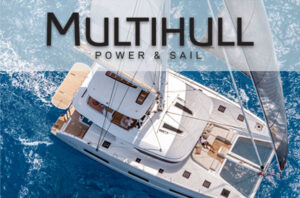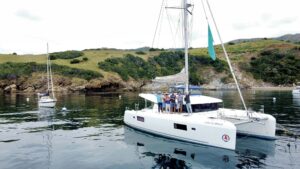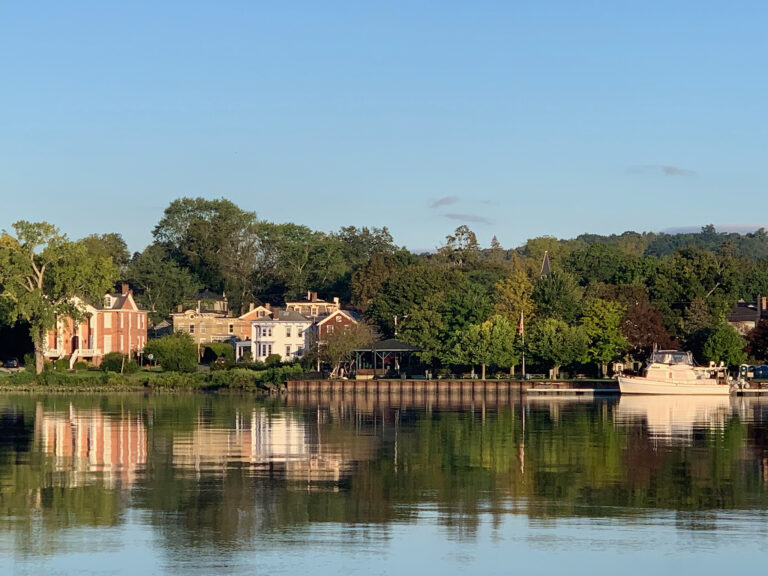There’s no holding back these multihull designers and builders. New designs are proliferating. Here are just a few of the latest.
Aero 48e

Long-term energy independence and a minimal carbon footprint were high on the brief given to French designers Martin Defline and Joubert/Nivelt for this 48ft cruising cat. Hence the Aero 48e packs more solar panels than ever seen on a cruising cat of this size, backed up by a brace of wind generators. Their combined output feeds a pair of electric saildrives that also generate power when the boat is sailing. To keep shadows off the solar panels atop the hard bimini, the rig is headsail-only, with a big overlapping genoa providing motive power for the 15,500lb carbon/epoxy composite cruiser. Another interesting feature is the tandem keel design, highly unusual on a multihull. Aerofleet; aerofleet.be
LOA 48ft // LWL 46ft
BEAM 24ft 6in // DRAFT 4ft 3in DISPLACEMENT 15,600lb
Rapier 550

Broadblue’s managing director Mark Jarvis describes the Rapier 550 as “the first in a new breed of eco-superyachts, capable of crossing oceans in style, in comfort and with no fuel cost.” Designed by Darren Newton of Dazcat fame, the carbon-fiber/epoxy/e-glass/foam-core composite boat displaces a little over 20,000lbs and is driven by a lofty carbon-fiber rig.
In line with the latest thinking, the mast is stepped well aft in order to expand the foretriangle to maximize the size of the self-tacking jib. The resulting high-aspect square-headed mainsail is therefore much easier to handle than the heavily roached mainsails employed on performance cats for many years. Broadblue Catamarans; broadblue.com
LOA 52ft 6in // LWL 52ft 6in
BEAM 26ft 2in // DRAFT 3ft 4in
DISPLACEMENT 26,000lb
Flying Phantom

Touted as the world’s first production foiling beach cat, the Flying Phantom was developed from Martin Fischer’s championship-winning F18 design. The people at Sail Innovation kept the F18 hull design, but made the boat wider and lighter, gave it a new rig, and slotted in a set of L-shaped daggerboards and T-shaped rudders. Franck Cammas, legendary French multihull sailor and C-Class world champ, provided invaluable input. Phantom International; phantom-international.com
LOA 18ft // LWL 18ft
BEAM 9ft 10in // DRAFT 1ft/3ft 3in DISPLACEMENT N/A
Slyder 47

This interesting take on a performance cruiser is from designer Francois Perus, and hull #1 should have hit the water right around the time this magazine went to press. It’s a good-looking lightweight speedster aimed at the niche currently dominated by builders like Outremer and Catana and should be capable of fast passage times. A pair of Oceanvolt electric saildrives provides auxiliary power, with a generator and solar panels to charge the twin banks of four lithium batteries. Slyder Yachts; slyderyachts.com
LOA 46ft 10in // LWL 46ft 10in
BEAM 23ft 5in // DRAFT 2ft 2in/7ft 3in DISPLACEMENT N/A
Saba 50

The latest new offering from cruising cat builder Fountaine Pajot, the Saba 50 replaces the Salina 48. Designers Olivier and Isabelle Racopeau have crafted a handsome boat that’s stylistically in step with the company’s two flagship models, the Sanya 57 and the Victoria 67. A choice of interior layouts to suit either the cruising or charter markets offers up to five cabins, plus skipper’s accommodations, and there’s plenty of room out in the open air, too, with three distinct areas where the crew can spread out: the large cockpit aft, a sunbathing area forward and a bridgedeck with seating and sunbeds for crew who want to keep the helmsman company. Fountaine Pajot; fountaine-pajot.com
LOA 49ft 2in // LWL 47ft
BEAM 26ft 2in // DRAFT 4ft 1in // 3in DISPLACEMENT 34,600lb
Hobie T2

It was a 16-foot beach cat that helped launch Hobie as a worldwide brand, and the California company’s latest boat is another 16-footer, this one specifically configured for the 21st century. The T2 is constructed from rotomolded polyethylene and measures exactly 16 feet overall, with a beam of 7ft 8in. The 26-foot mast breaks into two sections for transport and has a float up top for safety. Weighing in at 388lb, the T2 can carry a 529lb payload. A brightly colored mainsail and furling jib are standard, and the optional spinnaker package will add some spice. Hobie Cat; hobiecat.com
LOA 16ft // BEAM 7ft 8in // DRAFT 10in (rudders up) // WEIGHT 388lb
O Yachts 46

The O Yachts business model brings back memories of the 1970s and ‘80s, when it was far from unusual for handy owners to buy a hull and deck, and then complete the rest of the boat themselves. Built in Latvia, the boats are available at any stage of completion, from bare hulls to fully fitted out, with plenty of latitude for owners to customize the boats to suit their own needs. For a base price of 120,000 Euros ($165,000) you get a hull and deck assembly with keels and rudders. The rest is up to you—or you can have the yard complete the boat for you. The Eric LeRouge design looks pretty and fast, and there are bigger versions in the works. O-Yachts; o-yachts.com
LOA 46ft // LWL 46ft
BEAM 24ft 10in // DRAFT 3ft 5in/3in DISPLACEMENT 14,300lb (light ship)
S2C45

The Swiss Catamaran Concept translates to a fast, comfortable and safe offshore cruiser. Following on from the successful S2C55, the S2C45 is aimed at shorthanded crews or sailors with young families who need a more compact, easily managed boat. The Sebastian Schmidt design features a carbon-fiber rig, daggerboards, hi-tech sails and a full cruising inventory—including air conditioning, a washing machine, a freezer and other luxuries—as standard. Swiss Catamaran Concept; swisscatamaran.com
LOA 45ft // LWL 44ft
BEAM 24ft 7in // DRAFT 3ft 4in/9ft 2in DISPLACEMENT 24,200lb








